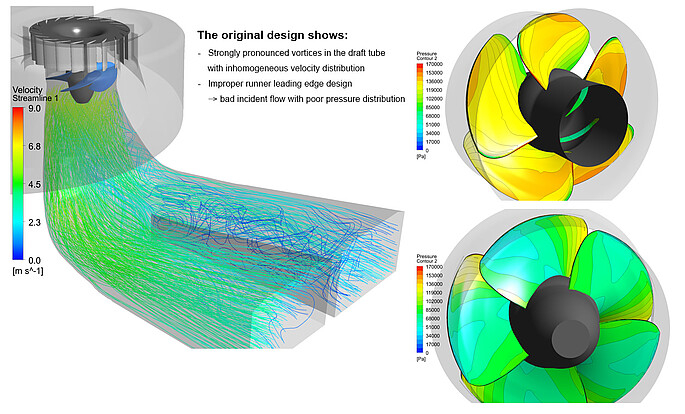Optimisation of a Kaplan turbine
on the basis of a CFD-based potential determination study
Last autumn, we reported on a CFD-based study to determine the potential of a historic hydropower plant commissioned by a major German energy supplier (☛ to the article: Potential assessment study for a historic hydropower plant).
In the course of this study, the performance data from a plant measurement several years ago was impressively confirmed. Based on a detailed analysis of the flow situation, optimisation measures were subsequently derived and the following three different optimisation variants were tested:
- Option 1: Blade optimisation while retaining the existing hub and the existing shroud contour
- Option 2: Blade optimisation while retaining the existing hub, but in combination with a NEW, extended contour of the shroud
- Option 3: Development of a completely new impeller with a reduced hub and extended shroud shape
Creation of the optimisation variants
Optimised Kaplan runners were developed for each of these three optimisation variants, which were used to numerically calculate the performance curves at nominal head. In the next step, the predicted annual working capacity and the percentage increase compared to the current situation were determined with the aid of the annual hydrograph and the production data from previous years. This procedure served as the basis for deciding on the most economical renewal measure for the hydropower plant.
In order to keep the replacement as low as possible and still be able to maximise the annual work, the operator decided to retain the existing hub and thus the number of blades, to replace the now badly damaged turbine shroud with a new and enlarged one, and to have a customised new runner manufactured (see option 2).
Customised optimisation ensures higher efficiency
The CFD simulation showed that the peak efficiency could be increased by around 2.5 percentage points and the cavitation-proof flow could be increased from around Q = 85 m³/s to around Q = 95 m³/s per turbine. The final economic efficiency analysis thus resulted in an almost 4% increase in the annual capacity.
Based on this study, the operator has now decided to convert the first of the two turbines at the end of 2025 and thus bring it up to the latest state of the art.
Referring to the best efficiency point at nominal head, the following figures show a comparison of the flow situation in the draft tube and in the turbine runner with the current runner version (top) and the optimised runner (below).
Customised optimisation of the Kaplan runner resulted in improved pressure distribution on the significantly shortened runner blades and a separation-free flow in the draft tube.

Subscribe and benefit
Stay informed about our
- conferences
- continuing education programmes
- activities




